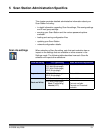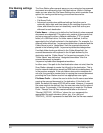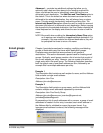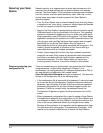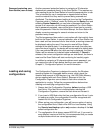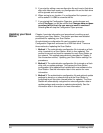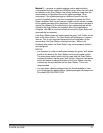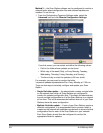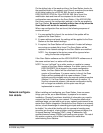
A-61588 July 2008 5-9
On the defined day of the week and time, the Scan Station checks for
the specified folder on the network, and if found, examines the contents
of the folder looking for a KSS100.XML file and an optional
KSS100UPDATE.EXE file. If the KSS100.XML file is found, the
modification date and time will be compared to the last time a
configuration was executed on the Scan Station. If the KSS100.XML
file is more current, the configuration settings in the file are applied to
the Scan Station. Be sure to carefully select a time of day when the
Scan Station will be idle for automatic updates.
When new configuration files are found, the following sequence of
events will occur.
1. If a new update file is found, the contents of the update will be
applied to the Scan Station.
2. If newer settings are found, the settings will be applied to the Scan
Station as the new default settings.
3. If required, the Scan Station will be restarted. A restart will always
occur when an update file is found. The Scan Station will be
restarted if the network settings for the Scan Station are modified.
NOTE: Any changes to the device name will be ignored when
using the remote configuration.
If the Scan Station software and the KSS100UPDATE software are at
the same revision level, no action will be taken.
NOTE: You can “roll-back” to an older version or update to a newer
version of the Scan Station software. If an older version of the
KSS100UDPATE file is placed in the remote configuration
folder, the Scan Station will be rolled back to use the older
version of the software. If a newer version is found, the Scan
Station will be updated with this newer software. These
methods are also available using the manual update procedure
(Method 1). If a Scan Station is updated back to version 1.5,
(the first commercial release), the remote configuration facility
will no longer be available, as this option was not yet
implemented in version 1.5.
Network configura-
tion details
When installing and configuring your Scan Station, there are some
things you can do, as an administrator, to prepare for an easier
installation. Chapter 2 provides a checklist of information you need to
connect the Scan Station to your network. This section details what
additional steps you can take to set up your network environment for an
easier Scan Station integration. Because the Scan Station is a network
device, a basic knowledge of networking principals and terminology will
be helpful. You should be familiar with the concept of creating user
accounts (on domains), sharing folders, setting access privileges, the
Universal Naming Convention (UNC), using IP addresses, fully
qualified domain names (FQDNs) and creating user groups. The rest of
this section contains a list of Best Practices to be used when
administering Scan Stations.



